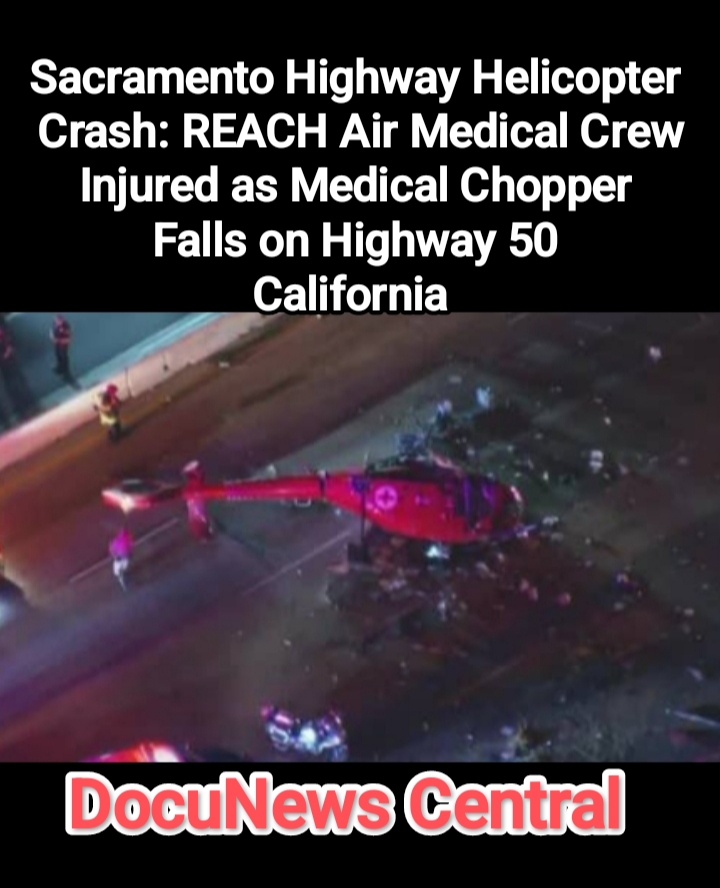

By DocuNews Central | October 7, 2025 | Sacramento, California
A medical helicopter operated by REACH Air Medical Services plummeted onto Highway 50 in Sacramento on Monday evening, October 6, leaving multiple people seriously injured and traffic completely shut down for hours. The shocking crash sparked widespread panic, a massive emergency response, and an ongoing federal investigation into what authorities described as a “catastrophic aviation incident.”
Eyewitnesses watched in disbelief as the air ambulance spiraled downward, struck the highway, and scattered debris across several lanes. According to officials, no patient was aboard, but the three crew members sustained severe injuries and were rushed to area hospitals. The Sacramento Fire Department, California Highway Patrol (CHP), and National Transportation Safety Board (NTSB) are now jointly investigating what led to the midair failure that caused the tragedy.
🚁 A Routine Flight Turns into a Disaster
The aircraft, belonging to REACH Air Medical Services, had been on a routine transfer flight when it suddenly began losing altitude. Witnesses reported hearing unusual engine noises moments before the helicopter hit the eastbound lanes of Highway 50, just west of 59th Street, a few miles from downtown Sacramento.
The crash happened around 5:00 p.m., right at the peak of evening rush hour. Motorists on the busy highway were stunned as the helicopter descended rapidly and hit the asphalt, forcing drivers to brake abruptly to avoid the wreckage.
According to Reuters, first responders reached the site within minutes, and all eastbound lanes were immediately shut down to allow paramedics, police, and firefighters to conduct rescue operations. The Sacramento Fire Department confirmed that “multiple victims” had been pulled from the wreckage and transported to local hospitals in critical condition.
Witnesses Describe a Terrifying Scene
Motorists who witnessed the crash described chaos and confusion. One driver, Megan Dorsey, told ABC News, “It was like something out of a movie. The helicopter came down spinning, and then there was a loud bang. Everyone screamed, and cars swerved everywhere.”
Another witness shared footage on social media showing the red-and-white REACH helicopter lying twisted in the middle of the highway, surrounded by emergency vehicles. Flames briefly erupted before firefighters extinguished them using foam and water cannons.
Several witnesses said they saw crew members trapped inside the cockpit as rescuers struggled to free them. The images quickly spread online, prompting an outpouring of prayers and concern for the medical team.
🔥 The Immediate Response from Authorities
The Sacramento Fire Department and California Highway Patrol were first on the scene. Within minutes, a coordinated rescue operation began. Crews deployed hydraulic tools to cut through the fuselage and extract the trapped personnel.
Traffic officers closed both eastbound and westbound lanes of Highway 50 between Watt Avenue and 59th Street to secure the area and prevent secondary accidents. Helicopters from nearby hospitals hovered above to assist with airlifting victims.
By 6:00 p.m., all three crew members had been safely extracted and sent to UC Davis Medical Center and Mercy General Hospital for emergency treatment. Officials later confirmed that no motorists were killed, although a few sustained minor injuries from debris.
According to AP News, investigators from the NTSB and Federal Aviation Administration (FAA) arrived on site later that night to begin collecting evidence. They examined rotor fragments, engine parts, and onboard instruments to determine what caused the catastrophic failure.
⚙️ Investigation Underway: What Could Have Gone Wrong?
As dawn broke Tuesday morning, investigators continued combing through the crash site. The NTSB announced that it would release a preliminary report within two weeks, providing initial findings. However, the full investigation could take months.
Experts believe the crash might have been caused by mechanical malfunction or loss of engine power. Aviation analyst James Holland told The San Francisco Chronicle that air ambulances are often subjected to rigorous maintenance schedules, making such failures extremely rare.
“The REACH fleet has an excellent safety record,” Holland noted. “For a helicopter to go down so suddenly, something catastrophic must have happened midair.”
Sacramento Fire Chief Chad Augustin confirmed that no distress call was made before the crash. “The aircraft appeared to have lost control almost instantly,” he said. “Our priority was saving lives and preventing fire from spreading.”
🚧 Highway 50 Remained Closed for Hours
The aftermath brought the entire Highway 50 corridor to a standstill. Thousands of commuters were stranded as emergency services worked through the night. Vehicles were redirected through Elvas Avenue, J Street, and Business 80, while large cranes were used to remove the damaged helicopter from the freeway.
By 2:00 a.m. Tuesday, two eastbound lanes were reopened, but residual traffic stretched for several miles. California Highway Patrol urged motorists to remain patient as the cleanup and investigation continued.
Local authorities praised drivers for their cooperation and credited the rapid response of firefighters for preventing what could have been a much greater tragedy.
💬 Statements from REACH Air Medical Services
In an official statement released late Monday, REACH Air Medical Services confirmed that the helicopter involved was one of its Eurocopter EC135 models, widely used for medical emergencies. The company expressed deep concern for its injured employees and extended gratitude to emergency responders.
“We are devastated by the incident that occurred in Sacramento,” the statement read. “Our focus remains on supporting our crew members and their families during this challenging time. We appreciate the heroic efforts of first responders and hospital staff who provided immediate care.”
The company also promised to fully cooperate with federal investigators to determine the root cause of the crash and to prevent similar incidents in the future.
🕊️ No Fatalities, But Deep Shock Across the Community
While there were no confirmed fatalities, the crash sent shockwaves throughout the Sacramento community. Residents took to social media to express relief that no one on the ground was killed, while also offering prayers for the injured crew.
Local hospitals reported stable conditions for two of the three crew members as of Tuesday morning. The third remained in critical care.
Sacramento Mayor Darrell Steinberg described the event as “a grim reminder of the risks that emergency medical crews face every day to save others.” He added, “Our city stands united in gratitude and support for those brave individuals who put their lives on the line.”
🗞️ National Coverage from Credible Sources
- AP News confirmed the crash, highway closure, and ongoing investigation.
- Reuters verified multiple injuries and the involvement of REACH Air Medical Services.
- ABC News provided exclusive witness interviews and footage.
- The San Francisco Chronicle published detailed location data and insights from aviation analysts.
- The Sacramento Bee reported that the helicopter came down near 59th Street and was removed by cranes after midnight.
🔎 The Broader Implications for Air Medical Safety
The Sacramento helicopter crash reignited national discussions about air medical transport safety. According to the Federal Aviation Administration (FAA), air ambulances play a vital role in critical care transport, but they operate under high-risk conditions—often in poor weather, difficult terrain, or heavy urban traffic.
Since 2010, the FAA has implemented stricter regulations for medical flight operators, including enhanced training and advanced onboard tracking systems. REACH Air Medical Services, a subsidiary of Global Medical Response, has long been recognized for its compliance with these safety standards.
Aviation expert Dr. Laura Jensen told ABC10 Sacramento, “This crash doesn’t necessarily indicate systemic failure. However, it highlights why continuous monitoring, timely maintenance, and robust communication systems are vital to air medical missions.”
🕵️ What Comes Next
The NTSB and FAA will analyze every piece of evidence collected from the wreckage. Black box recordings, maintenance records, and flight path data will be reviewed to determine what went wrong. Investigators are also expected to interview witnesses, maintenance personnel, and the surviving crew once they recover.
Preliminary findings will likely focus on engine failure, fuel system integrity, and pilot control systems. If no mechanical defects are discovered, investigators may examine environmental factors such as wind turbulence or bird strikes.
🧭 A City United in Recovery
Despite the shock, Sacramento’s resilience has been evident. Blood donation centers reported an increase in donors overnight, while local restaurants provided free meals to emergency personnel working through the night.
Community members gathered near the crash site Tuesday morning to leave flowers and cards expressing support for the injured crew. A small vigil was organized outside UC Davis Medical Center, where the most critically injured pilot remains under observation.
City officials assured residents that Highway 50 would reopen fully by midweek once all safety checks are complete.
🌍 A Story That Captured National Attention
As footage of the crash spread nationwide, tributes poured in from healthcare professionals, pilots, and rescue workers across the United States. The event has become a symbol of courage and sacrifice within the emergency medical community.
On social media, hashtags like #SacramentoHelicopterCrash, #REACHAir, and #Highway50Incident trended globally. Supporters praised the bravery of medical pilots who risk their lives to save others every day.
all right @Docunews Central.






